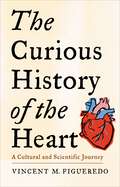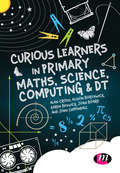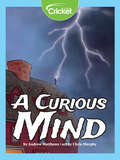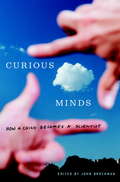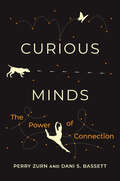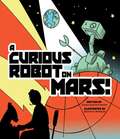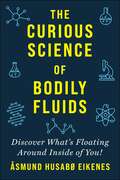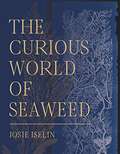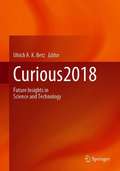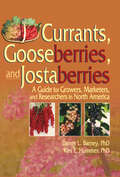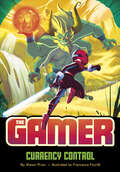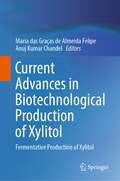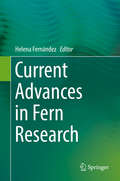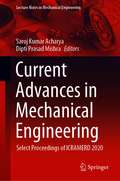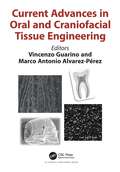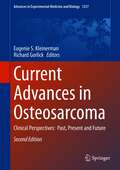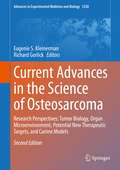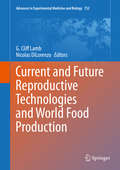- Table View
- List View
Curious George Discovers Plants (Curious George)
by H. A. ReyGeorge's friend Chef Pisghetti makes the most delicious vegetable soup! When the chef is running low on fresh vegetables, George wants to lend a hand in the rooftop garden--but he has a lot to learn about greenery. Come along as George discovers all about gardening, plants, what makes them grow, and why they're important. Based on the Emmy-winning PBS show, this story is filled to the brim with additional facts, real photos, experiments, activities, and more. Learning about science has never been so much fun!
Curious George Discovers Recycling (Curious George)
by H. A. ReyCurious George wants to help clean up the planet, and recycling seems like a good place to start—but where does he begin? Follow along with George as he learns about what recycling is, how it works, and what else he can do to reduce his monkey paw print. Readers will learn the difference between recycling and trash, what happens to the things we throw away, and other ways to help keep our planet clean. Based on Curious George, the Emmy Award-winning PBS TV show, this story also includes fun facts, real photos, experiments, activities, and more. Learning about science has never been so much fun!
Curious George Discovers Space (Curious George)
by H.A. ReyCurious George embarks on an out-of-this world adventure and lends some helping hands—and feet—to save the space station astronauts. George is thrilled to visit the Space Center to help Professor Pizza and Professor Einstein. First up, he&’s making a special delivery to the international space station. Then it&’s time to help solve a problem with the Mars rover, and George dreams of going where no monkey (or human) has gone before—Mars! Join George on an exciting journey into outer space and learn all about space travel, gravity, the solar system, and Mars. Based on the Emmy-winning PBS show, this story is filled to the brim with additional facts, real photos, experiments, activities, and more. Learning about science has never been so much fun!
Curious George Discovers the Seasons
by H. A. ReyThe seasons are changing and winter is closing in. George has toys for warm weather and toys for snowy weather—but what’s a monkey to do when winter days are just plain cold? When he decides to ignore the weather and play with his wading pool and bubbles, George learns some interesting things about weather, temperature, and freezing and melting. Learn all about the four seasons with your favorite monkey! Based on the Emmy-winning PBS show, this story is filled to the brim with additional facts, real photos, experiments, activities, and more. Learning about science has never been so much fun!
The Curious History of the Heart: A Cultural and Scientific Journey
by Vincent M. FigueredoFor much of recorded history, people considered the heart to be the most important organ in the body. In cultures around the world, the heart—not the brain—was believed to be the location of intelligence, memory, emotion, and the soul. Over time, views on the purpose of the heart have transformed as people sought to understand the life forces it contains. Modern medicine and science dismissed what was once the king of the organs as a mere blood pump subservient to the brain, yet the heart remains a potent symbol of love and health and an important part of our cultural iconography.This book traces the evolution of our understanding of the heart from the dawn of civilization to the present. Vincent M. Figueredo—an accomplished cardiologist and expert on the history of the human heart—explores the role and significance of the heart in art, culture, religion, philosophy, and science across time and place. He examines how the heart really works, its many meanings in our emotional and daily lives, and what cutting-edge science is teaching us about this remarkable organ. Figueredo considers the science of heart disease, recent advancements in heart therapies, and what the future may hold. He highlights the emerging field of neurocardiology, which has found evidence of a “heart-brain connection” in mental and physical health, suggesting that ancient views hold more truth than moderns suspect.Ranging widely and deeply throughout human history, this book sheds new light on why the heart remains so central to our sense of self.
The Curious Human Knee
by Han YuWhere would we be without the knee? This down-to-earth joint connecting the thigh and the lower leg doesn’t receive the attention it deserves. Yet, as The Curious Human Knee reveals, it is crucial to countless facets of science, medicine, culture, and history—and even what makes us human.The science writer Han Yu provides an informative, surprising, and entertaining exploration of the human knee across time and place. She begins with our earliest ancestors, emphasizing that walking upright separates us from the apes and bipedal knees appeared long before big brains and sophisticated tools. Yu considers the intricate anatomy of the knee, its evolutionary history, and the complexity of treating knee pain, including her own. She examines why women’s knees might be more prone to damage than men’s and addresses the roles of race and class in ailments such as osteoarthritis. This book gets knee-deep into an astonishing range of topics—fashion from flappers to miniskirts and ripped jeans, cultural practices spanning Japanese knee walking and Thai boxing, and more. Yu reflects on the symbolic power of kneeling from the imperial court in China to the football field in the United States and shows why the knee figures into so many social and political phenomena.Distilling a vast amount of research in a style that is engaging, conversational, and even personal and witty, this book opens readers’ eyes to the complexity and significance of the humble knee.
Curious Learners in Primary Maths, Science, Computing and DT
by Jon Chippindall Jon Board Karen Beswick Alison Borthwick Alan CrossWhether it is in the National Curriculum or the Teachers' Standards, promotion of children's curiosity is highlighted as a key part of effective teaching. Curiosity has the potential to enhance learning in all curriculum subjects but it has a special connection with scientific thinking. A curious approach can open up learning in science, computing, design technology and mathematics. This text explores how teachers can harness the power of curiosity in their classroom. Full of practical teaching ideas for engaging learners and making lessons more exciting, it highlights the ways in which STEM subjects can be taught together. Coverage includes: the place of curiosity in subject teaching how curiosity contributes to a learner's overall capability examples of curiosity in primary STEM classes case studies which exemplify curiosity.
Curious Learners in Primary Maths, Science, Computing and DT
by Alan Cross Jon Board Jon Chippindall Karen Beswick Alison BorthwickWhether it is in the National Curriculum or the Teachers' Standards, promotion of children's curiosity is highlighted as a key part of effective teaching. Curiosity has the potential to enhance learning in all curriculum subjects but it has a special connection with scientific thinking. A curious approach can open up learning in science, computing, design technology and mathematics. This text explores how teachers can harness the power of curiosity in their classroom. Full of practical teaching ideas for engaging learners and making lessons more exciting, it highlights the ways in which STEM subjects can be taught together. Coverage includes: the place of curiosity in subject teaching how curiosity contributes to a learner's overall capability examples of curiosity in primary STEM classes case studies which exemplify curiosity.
A Curious Mind
by Andrew MatthewsBenjamin Franklin was often curious about the world around him. Utilizing observation and testing of the scientific method, he was able to invent many new items that improved the world for others. These inventions include his famous bifocal glasses, lightning rod, and even a long extension arm.
Curious Minds: How a Child Becomes a Scientist
by John BrockmanA fascinating collection of essays from twenty-seven of the world's most interesting scientists about the moments and events in their childhoods that set them on the paths that would define their lives. What makes a child decide to become a scientist? *For Robert Sapolsky--Stanford professor of biology--it was an argument with a rabbi over a passage in the Bible. *Physicist Lee Smolin traces his inspiration to the volume of Einstein's work he picked up as a diversion from heartbreak. *Mihaly Csikszentmihalyi, a psychologist and the author of Flow, found his calling through Descartes. *Mary Catherine Bateson--author of Composing a Life--discovered that she wanted to be an anthropologist while studying Hebrew. *Janna Levin--author of How the Universe Got Its Spots--felt impelled by the work of Carl Sagan to know more. Murray Gell-Mann, Nicholas Humphrey, Freeman Dyson, Daniel C. Dennett, Lynn Margulis, V. S. Ramachandran, Howard Gardner, Richard Dawkins, and more than a dozen others tell their own entertaining and often inspiring stories of the deciding moment. Illuminating memoir meets superb science writing in essays that invite us to consider what it is--and isn't--that sets the scientific mind apart and into action.
Curious Minds: The Power of Connection
by Perry Zurn Dani S. BassettAn exhilarating, genre-bending exploration of curiosity&’s powerful capacity to connect ideas and people.Curious about something? Google it. Look at it. Ask a question. But is curiosity simply information seeking? According to this exhilarating, genre-bending book, what&’s left out of the conventional understanding of curiosity are the wandering tracks, the weaving concepts, the knitting of ideas, and the thatching of knowledge systems—the networks, the relations between ideas and between people. Curiosity, say Perry Zurn and Dani Bassett, is a practice of connection: it connects ideas into networks of knowledge, and it connects knowers themselves, both to the knowledge they seek and to each other. Zurn and Bassett—identical twins who write that their book &“represents the thought of one mind and two bodies&”—harness their respective expertise in the humanities and the sciences to get irrepressibly curious about curiosity. Traipsing across literatures of antiquity and medieval science, Victorian poetry and nature essays, as well as work by writers from a variety of marginalized communities, they trace a multitudinous curiosity. They identify three styles of curiosity—the busybody, who collects stories, creating loose knowledge networks; the hunter, who hunts down secrets or discoveries, creating tight networks; and the dancer, who takes leaps of creative imagination, creating loopy ones. Investigating what happens in a curious brain, they offer an accessible account of the network neuroscience of curiosity. And they sketch out a new kind of curiosity-centric and inclusive education that embraces everyone&’s curiosity. The book performs the very curiosity that it describes, inviting readers to participate—to be curious with the book and not simply about it.
A Curious Robot on Mars!
by Bethany Straker James Duffett-SmithFar off into space--186 million miles to be precise--a fearless robot rover travels all by his lonesome. He is on a crucial mission from Earth, eagerly seeking to answer the much-anticipated question: Does life exist on Mars? But there is nothing to be seen on this planet except miles of rocks. He loses support from mission control and finds himself alone and cut off from civilization. But the curious little robot is resilient! After noticing a flash of light shining brilliantly through the crack of a rock, he instantly realizes his mission is far from over. He slowly inches towards the edge, but then suddenly falls perilously into the darkness! What will he discover?Bethany Straker's vibrant illustrations accompany James Duffett-Smith's suspenseful tale of discovery and hope. A Curious Robot on Mars! will motivate any and all readers to strive for one's ambitions--and most importantly, to always be curious!
Curious Science of Bodily Fluids: Discover What's Floating Around Inside of You!
by Åsmund EikenesFascinating details on everyday fluids!In The Curious Science of Bodily Fluids, readers meet, among others, a brain researcher, a urologist and a chef. They share stories and personal experiences, which together with the latest from the world of research offer startling, new knowledge about body fluids. Some of the revelations include: The water in the brain washes away rubbish while you sleep. The mucus in the cervix helps healthy sperm to reach the egg. Tiny drops of snot can float in the air for a full ten minutes after a strong sneeze. The blood of young people may contain a source of eternal life.And many more!The perfect gift for those interested in popular science!
Curious Species: How Animals Made Natural History
by Whitney Barlow RoblesA compelling and innovative exploration of how animals shaped the field of natural history and its ecological afterlives Can corals build worlds? Do rattlesnakes enchant? What is a raccoon, and what might it know? Animals and the questions they raised thwarted human efforts to master nature during the so-called Enlightenment—a historical moment when rigid classification pervaded the study of natural history, people traded in people, and imperial avarice wrapped its tentacles around the globe. Whitney Barlow Robles makes animals the unruly protagonists of eighteenth-century science through journeys to four spaces and ecological zones: the ocean, the underground, the curiosity cabinet, and the field. Her forays reveal a forgotten lineage of empirical inquiry, one that forced researchers to embrace uncertainty. This tumultuous era in the history of human-animal encounters still haunts modern biologists and ecologists as they struggle to fathom animals today. In an eclectic fusion of history and nature writing, Robles alternates between careful historical investigations and probing personal narratives. These excavations of the past and present of distinct nonhuman creatures reveal the animal foundations of human knowledge and show why tackling our current environmental crisis first requires looking back in time.
The Curious World of Seaweed: Stories from the Pacific Coast
by Josie IselinMarine algae are the supreme eco-engineers of life: they oxygenate the waters, create habitat for countless other organisms, and form the base of a food chain that keeps our planet unique in the universe as we know it. In this beautiful volume Josie Iselin explores both the artistic and the biological presence of sixteen seaweeds and kelps that live in the thin region where the Pacific Ocean converges with the North American continent—a place of incomparable richness. Each species receives a detailed description of its structure, ecological importance, and humans’ scientific inquiry into it, told in scientifically illuminating yet deeply reverent and inspired prose. Throughout the writings are historical botanical illustrations and Iselin’s signature, Marimekko-like portraits of each specimen that reveal their vibrant colors—whether rosy, “olivaceous,” or grass-green—and whimsical shapes. Iselin posits that we can learn not only about the seaweeds but also from them: their resilience, their resourcefulness, their poetry and magic.
Curious2018: Future Insights in Science and Technology
by Ulrich A. K. BetzThis book expands the debate on the future of science and technology at the Curious2018 – Future Insight Conference, held on the occasion of Merck’s 350-year anniversary. In the respective chapters, some of the world’s top scientists, managers and entrepreneurs explore breakthrough technologies and how they can be applied to make a better world for humanity.Divided into three parts, the book begins with an introduction to the vision of the conference and to the importance of curiosity for innovation, while also exploring the latest scientific developments that are shaping the future of healthcare, medicine, the life and material sciences, digitalization and new ways of working together. In the second part, particular attention is paid to new therapies and diagnostics; here, readers will learn how synthetic biology and chemistry are being used to solve problems that are essential to the future of humanity. The role of in-silico research is also discussed. In the final part of the book, readers will find some thoughts on ethical principles guiding our application of science and technology to create a bright future for humanity.Given its interdisciplinary appeal, the book will inspire curiosity in a wide readership, from scholars and researchers to professionals with an interest in exploring the future of science and technology, solving the problems of today, and paving the way for a better tomorrow.Chapters 1, 2, 3 and 17 are available open access under a Creative Commons Attribution-NonCommercial 4.0 International License via link.springer.com.
Currants, Gooseberries, and Jostaberries: A Guide for Growers, Marketers, and Researchers in North America
by Kim Hummer Danny BarneyRediscover the economic potential of growing Ribes cultivars in the United States and Canada! Currants, Gooseberries, and Jostaberries: A Guide for Growers, Marketers, and Researchers in North America explores the biology and history of growing these small fruits as commercial crops in North America. This book provides authoritative inf
Currency Control (The Gamer)
by Shawn PryorEvil Cynthia Cyber is robbing banks with her latest creation, a villain named Currency. The stolen money will go toward building a machine that can capture people in a simulation program. There she could control every victim’s life. It's up to the Gamer to stop Cynthia Cyber from taking over the world!
Current Advances in Biotechnological Production of Xylitol: Fermentative Production of Xylitol
by Maria das Graças de Almeida Felipe Anuj Kumar ChandelThis book explores recent advances in the microbial production of xylitol and its applications in food and medical sector. Xylitol is an important biomolecule from lignocellulose biorefinery which is produced from the xylose by chemical reactions or microbial fermentation methods. Currently, the demand of xylitol at commercial scale is being met through chemical methods. However, recent breakthroughs made in plant cell wall destruction, genetic engineering to develop the designer microorganisms, fermentation methods and media formulations and downstream processing have led the ways for sustainable production of xylitol at commercial scale in lignocellulose biorefineries. Microbial production of xylitol is preferred over the chemical processes as it is environmentally friendly, higher process efficiency with the desired product yield, and product recovery with minimum impurities. This book is a unique compilation of 11 book chapters written by experts in their respective fields. These chapters present critical insights and discuss the current progress and future progress in this area into fermentative xylitol production.Chapter 9 is licensed under the terms of the Creative Commons Attribution 4.0 International License. For further details see license information in the chapter.
Current Advances in Fern Research
by Helena FernándezFerns, collectively, represent an ancient species of vascular plant which has a direct connection to the beginning of life on Earth. Today they are valued for their ornamental appeal, environmental benefit or as sources of health benefiting metabolites. Current pteridology, the study of fern, encompasses a wide range of research activities including, but not limited to, plant physiology, stress tolerance, genetics and genomics. The goal of this book is to compile the most relevant research done with ferns during the last decade. It is organized into four parts: I, Biology and Biotechnology; II, Evolution and Conservation; III, Metabolism and Genetic Resources, and IV, Environment. Each section reveals the utilization of ferns as a tool to explore challenges unique to plant development and adaptation.This project represents our collective effort to raise the awareness of ferns as a model system to study higher plant functions. Among the distinctive features of our proposed book are: (i) a wide range of topics with contributing researchers from all around the world, and (ii) recent advances of theoretic and applied knowledge with implications to crop species of economic value.
Current Advances in Mechanical Engineering: Select Proceedings of ICRAMERD 2020 (Lecture Notes in Mechanical Engineering)
by Saroj Kumar Acharya Dipti Prasad MishraThis book presents select proceedings of the International Conference on Recent Advances in Mechanical Engineering Research and Development (ICRAMERD 2020). The contents focus on latest research and current problems in various branches of mechanical engineering. Some of the topics discussed here include fracture and failure analysis, fuels and alternative fuels, combustion and IC engines, advanced manufacturing technologies, powder metallurgy and rapid prototyping, industrial engineering and automation, supply chain management, design of mechanical systems, vibrations and control engineering, automobile engineering, fluid mechanics and machines, heat transfer, composite materials, micro and nano-engineering for energy storage and conversion, and modeling and simulations. The wide range of topics presented in this book can make it useful for beginners, researchers as well as professionals in mechanical engineering.
Current Advances in Oral and Craniofacial Tissue Engineering
by Vincenzo Guarino and Marco Antonio Alvarez-PérezOral tissue engineering involves the study of current approaches for in vitro regeneration of soft and hard tissues located into the oral cavity. In this context, recent approaches involves the use of innovative biomaterials to replace the lost or damaged human oral tissues. Recent discoveries in materials science and nanotechnology are drastically changing the traditional approach to dentistry by the design of innovative devices able more efficiently supporting the natural regeneration process. The objective of this book is to highlight current progress in tissue engineering for various dental hard/soft tissues including enamel, dentin, pulp, alveolar bone, periodontium, gum and oral mucosa, by emphasizing the role of materials and their specific applications.
Current Advances in Osteosarcoma: Clinical Perspectives: Past, Present and Future (Advances in Experimental Medicine and Biology #1257)
by Eugenie S. Kleinerman Richard GorlickThis thoroughly revised second edition complied in 2 books is an up-to-date overview of the current clinical advances in sarcoma and osteosarcoma. The new edition features detailed, in-depth discussions of microRNAs in osteosarcoma, historical perspectives of chemotherapy in the treatment of the disease, tumor targeted IL12 therapy and HER2 targeted therapy, the role of enhancer elements in regulating the prometastatic transcriptional program and more. Further, these essential volumes also includes new insights on Wnt signaling in osteosarcoma, the role of genomics, genetically modified T-cell therapy, liquid biopsy, oncolytic viruses, immunophenotyping, receptor tyrosine kinases and epigenetic-focused approaches for treatment of osteosarcoma metastases, as well as thoughts on the current standard of treatment for patients suffering from these cancers. In the years since the previous edition, there have been numerous new developments in this rapidly changing field; this new edition is both timely and urgently needed. When taken together these companion volumes, Current Clinical (Book 1) and Scientific (Book 2) Advances in Osteosarcoma, are a timely and urgently needed guide for laboratory investigators and clinical oncologists focused in sarcoma.
Current Advances in the Science of Osteosarcoma: Research Perspectives: Tumor Biology, Organ Microenvironment, Potential New Therapeutic Targets, and Canine Models (Advances in Experimental Medicine and Biology #1258)
by Eugenie S. Kleinerman Richard GorlickThis thoroughly revised second edition is an up-to-date overview of the new advances in the knowledge of the basic science in sarcoma and osteosarcoma. It features detailed, in-depth discussions of microRNAs in osteosarcoma, historical perspectives of chemotherapy in the treatment of the disease, tumor targeted IL12 therapy and HER2 targeted therapy, the role of enhancer elements in regulating the prometastatic transcriptional program and more. Further, this essential volume also includes new insights on Wnt signaling in osteosarcoma, the role of genomics, genetically modified T-cell therapy, liquid biopsy, oncolytic viruses, immunophenotyping, receptor tyrosine kinases and epigenetic-focused approaches for treatment of osteosarcoma metastases, as well as thoughts on the current standard of treatment for patients suffering from these cancers. In the years since the previous edition, there have been numerous new developments in this rapidly changing field; this new edition is both timely and urgently needed. When taken together these companion volumes, Current Clinical (Book 1) and Scientific (Book 2) Advances in Osteosarcoma, are a timely and urgently needed guide for laboratory investigators and clinical oncologists.
Current and Future Reproductive Technologies and World Food Production (Advances in Experimental Medicine and Biology #752)
by G. Cliff Lamb Nicolas DilorenzoThis book addresses the impacts of current and future reproductive technologies on our world food production and provides a significant contribution to the importance of research in the area of reproductive physiology that has never been compiled before. It would provide a unique opportunity to separate the impacts of how reproductive technologies have affected different species and their contributions to food production. Lastly, no publication has been compiled that demonstrates the relationship between developments in reproductive management tools and food production that may be used a reference for scientists in addressing future research areas. During the past 50 years assisted reproductive technologies have been developed and refined to increase the number and quality of offspring from genetically superior farm animal livestock species. Artificial insemination (AI), estrous synchronization and fixed-time AI, semen and embryo cryopreservation, multiple ovulation and embryo transfer (MOET), in vitro fertilization, sex determination of sperm or embryos, and nuclear transfer are technologies that are used to enhance the production efficiency of livestock species.




